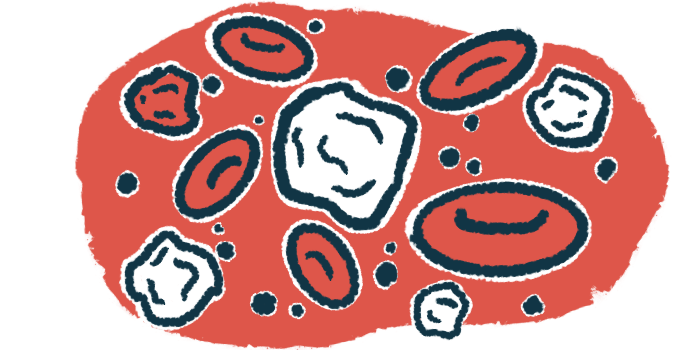Early study uncovers why FVIII inhibitors may develop in Hem A
Factor VIII can stimulate immune response on its own, researchers find

The protein missing or defective in people with hemophilia A, called blood coagulation factor VIII (FVIII), is able on its own to stimulate immune responses in a mouse model, a study suggests.
This immune response to FVIII is dependent on a set of distinct immune cells within the spleen, data show, and may also explain the formation of inhibitors that occurs with hemophilia A replacement therapy.
“Our goal was to provide a clearer understanding of how and why factor VIII inhibitors develop in individuals with this complication,” said Radek Kaczmarek, PhD, study co-lead at the Indiana University School of Medicine, said in a university news story. “We are hopeful that our findings will lead to more successful immune tolerance therapies for those living with hemophilia A and factor VIII inhibitors.”
The study, “Factor VIII trafficking to CD4+ T cells shapes its immunogenicity and requires several types of antigen-presenting cells,” was published in the journal Blood.
Nearly third of patients on replacement therapies develop immune response
Hemophilia A is a bleeding disorder caused by mutations in the F8 gene that result in a missing or defective FVIII protein. Replacement therapy is a standard treatment that supplies a functional version of FVIII to treat acute bleeds or prevent bleeding episodes.
Still, nearly a third of patients receiving replacement therapies develop an immune response against the treatment, generating neutralizing antibodies called inhibitors that can affect efficacy. Despite many years of clinical experience with this complication, little is known about the underlying mechanism of inhibitor formation.
“Development of new interventions is difficult without understanding the molecular and cellular underpinnings of an issue that is being addressed,” Kaczmarek said. “Cursory understandings of factor VIII inhibitor formation have stymied progress.”
B-cells are the immune cells that produce antibodies/inhibitors, and their activation relies on CD4-positive immune T-cells (also called helper T-cells). Before that, these T-cells are stimulated into action by antigen-presenting cells (APCs).
APCs take up immune-targeted proteins, called antigens, where they are broken down into fragments called peptides. These peptides are then presented on APC surfaces, which are recognized by CD4-positive immune T-cells, triggering an immune response against the antigen.
We are hopeful that our findings will lead to more successful immune tolerance therapies for those living with hemophilia A and factor VIII inhibitors.
Immune responses to blood-borne antigens occur in spleen
Immune responses to blood-borne antigens occur in the spleen, an organ behind the stomach composed of two main compartments: red and white pulp. Red pulp is responsible for clearing the blood of old red blood cells, microorganisms, and blood antigens, while white pulp houses antibody-producing B-cells and other immune cells.
In between the red and white pulp lies the marginal zone, where several specialized immune cells regulate the passage of cells between the two pulp compartments.
In the study, the researchers administered FVIII to a hemophilia A mouse model and found the protein was taken up by multiple types of APCs, particularly immune dendritic cells. As a comparison, mice were injected with ovalbumin, a protein found in chicken egg whites. Unlike FVIII, ovalbumin was taken up by different APCs, particularly immune macrophages located in red pulp.
B-cells and certain types of macrophages in the marginal zone, but not red pulp macrophages, were found to move FVIII to the white pulp. There, a select set of distinct APCs were then found to stimulate CD4-positive immune T-cells to transform into follicular helper T-cells (Tfh), which directly activate antibody-producing B-cells.
Consistently, the addition of a molecule that binds to Toll-like receptor 9, a pathway known to enhance Tfh cell responses via dendritic cells, accelerated inhibitor responses to FVIII.
“The most surprising finding in our study was that antigens may take different routes to reach T cell zones in the spleen,” said Roland Herzog, PhD, the study’s co-lead author. “These differences in trafficking offer a new perspective on why antigens differ in immunogenicity [immune responses].”
Hemophilia B replacement therapy did not elicit as many antibodies
Notably, the team also found that ovalbumin and blood-clotting factor IX, used as a replacement therapy for hemophilia type B, did not elicit antibodies at doses equal to a clinically relevant FVIII dose.
Furthermore, FVIII enhanced T-cell activation in response to ovalbumin, suggesting that “FVIII has intrinsic immunostimulatory properties, which affect the decision of whether to mount a response,” the researchers wrote.
They also noted that, in the clinic, FVIII inhibitors occur about five times more often in hemophilia A than FIX inhibitors in hemophilia B, despite much higher FIX protein doses.
“We propose that an antigen trafficking pattern that results in efficient in vivo [in living animals] delivery to [dendritic cells] and inflammatory signaling, shape the immunogenicity of FVIII,” the researchers wrote.








